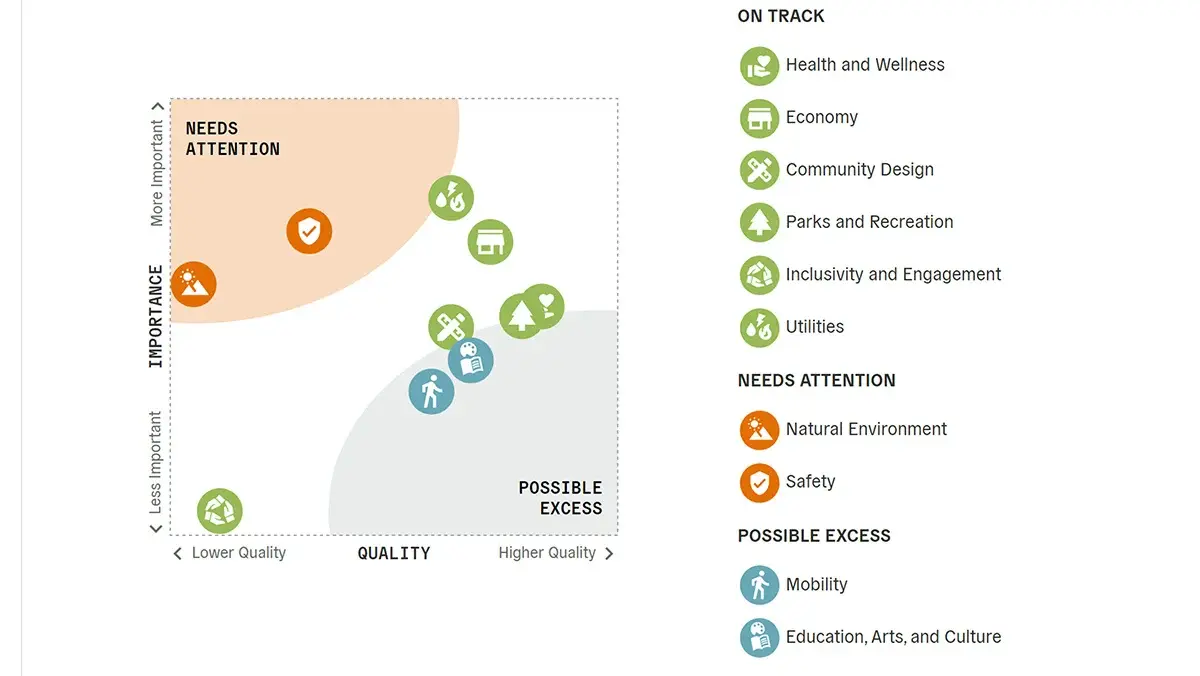How Polco Powers Strategic Planning in Five Steps
By Polco on May 19, 2023

Achieve strategic planning success with resident engagement and community data.
Local government decisions have a direct influence on residents’ daily lives. And any significant decision can have generational impacts on community livability. It’s one reason why resident engagement and meaningful data are an essential part of strategic planning. Resident engagement and data help governments align priorities, identify areas of livability that need improvement, gauge project progress, and maintain focus on long-term undertakings.
 “Everything that happens, happens at the local level,” said Matt Fulton, Polco National Director of Engagement, who worked as a city manager for over 30 years. “The uniqueness of local government is that it impacts everyone in some way, every day.”
“Everything that happens, happens at the local level,” said Matt Fulton, Polco National Director of Engagement, who worked as a city manager for over 30 years. “The uniqueness of local government is that it impacts everyone in some way, every day.”
Using engagement and data at various phases of the planning cycle guarantees strategic planning success—from start to finish.
1. Use Polco to Identify Community Successes and Challenges
Before going into planning, government leaders need a big-picture understanding of their community. Polco gives local governments this information multiple ways.
1. Community Surveys - Data Based on Resident Input
Polco assessments like The National Community Survey® (The NCS) ask residents about the quality of life in their city across many categories, such as the economy, environment, health, and much more. The NCS results give an overall view of performance and show where residents think their leaders should focus improvements.
These large-scale surveys conducted and analyzed by experts, so local governments get high-quality, trustworthy data. Surveys like The NCS give cities better representative feedback from their community as a whole, including under-heard groups.
2. Prebuilt Data Dashboards - Data From Public Sources
Polco also provides community insights from public sources that have been analyzed by data scientists presented on online dashboard. The indicators come from verified and trusted sources such as the Bureau of Labor Statistics and the U.S. Census.
Like Polco's resident surveys, the public data dashboards give counties, cities, and towns a sense of their performance across different areas of livability, such as health and transportation. The data is presented simply, so local governments easily spot strengths and challenge areas as a start to strategic planning.
 Example of Polco's public data Overview Dashboard, which provides a high-level view of your city's performance
Example of Polco's public data Overview Dashboard, which provides a high-level view of your city's performance
Officials can compare community surveys and data dashboards results to other local governments from across the nation. The comparability adds context to an individual community’s performance and offers guidance to where strategic focus is needed.
In both cases, the results may also validate what a government decision-maker intuitively knows, but provides actual data to support those instincts. With data-backed insights, leaders can feel confident in knowing their community’s needs.
Expert Planning Tip: Community Sentiment With Public Data Builds The Strongest Case for Strategic Planning Goals
Local governments can see community sentiment from The NCS side-by-side with their city data on the prebuilt dashboards. This provides even more detail on important data points and can reinforce any decision.
For instance, a city’s public data might show they score below the national average for affordable housing. The same city’s NCS results might show that 75% of residents are unhappy with affordable housing options. Collectively, this information reveals that housing is truly a problem in the community.
On the other hand, public data could show favorable housing trends while community sentiment data could show residents are unhappy with housing options. In this case, the city will want to consider how they can align resident perceptions with housing realities.
“If you can see where you stand, and complement that with resident sentiment, now all of a sudden you have a powerful backdrop for making decisions that can move your community forward,” Fulton said.

2. Use Polco to Align Priorities
Data from The NCS and public source data dashboards give officials information on where they should focus their energy. But change doesn’t happen unless the city council, departments, staff, and community members are on the same page.
The NCS shows consensus among residents, so decision-makers can see where they will have community member support. In the example above, government officials could feel more confident directing resources to affordable housing since most residents say housing is an issue.
Public data can also help unify council members with differing perspectives since the information clearly reveals areas of need.
“Alignment doesn’t mean everyone has to agree. But it's a shared understanding of the city’s goals and how certain projects fit into achieving those goals,” Fulton said.
3. Use Polco to Gauge Strategic Plan Progress
Local governments always have multiple projects happening simultaneously. Checking in with residents on an ongoing basis lets leaders know if their project is going planned or if they need to adjust. This prevents unnecessary spending on projects that can quickly become expensive.
Polco offers online polls and surveys for local governments to quickly get a pulse of the community throughout the strategic planning and project process. These online surveys are more targeted and shorter than assessments like The NCS. They also take less time to conduct.
4. Use Polco Data to Measure Strategic Plan Performance
With Polco, local governments can feel confident their data points show a true measure of success. Too often, local governments focus on quantitative metrics that don’t accurately portray their performance.
“With performance metrics, a high percentage of communities always think of their output—how many permits have they issued, how many people have they arrested. Many of these output measures have nothing to do with identifying how they are doing as a community,” Fulton said.
Looking at outcome-based data, the effects of an output, overtime lets governments know if their plan is working or not.
Polco clients receive time trends with their public data dashboards. And most cities conduct The NCS every two to three years as a way to track performance.

A screenshot of city's health-related data. The conducts The NCS regularly to track performance over time.
5. Use Polco to Maintain Focus and Relevance
Comprehensive plans typically cover a 10 to 15-year timeframe. Strategic plans are often on a one to three-year cycle. It can be challenging to keep up momentum on long-term projects. But losing focus on long-term plans and falling short of resident expectations could cause unrest and disapproval.
Consistent and ongoing communication is key to maintain alignment and keep strategic goals and priorities top-of-mind.
“Successful communities are very intentional in incorporating resident sentiment in their short and long-term planning efforts,” Fulton said. “Staying connected with all community stakeholders strengthens data-driven decisions, overall alignment, and ultimately trust in decision-making.”
Learn How Polco Can Help Your Local Government With Strategic Planning
Polco gives local governments valuable data that reveals where they should focus strategic plans. Resident sentiment and community data put stakeholders on the same page, so you can streamline the planning process and make the best decisions for your city.
Related Articles
Popular posts
Sign-up for Updates
You May Also Like
These Related Stories

Are You Ready for a State Audit? How to Prove Your Programs Deliver ROI

New Polco Survey Helps Leaders Assess COVID-19 Economic Impacts


